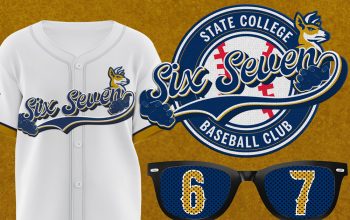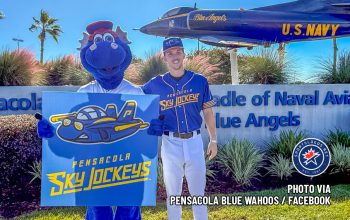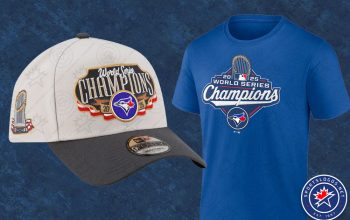
If your city once laid claim to the title “Hosiery Capital of the South” and you’re trying to name a minor league baseball team, it would be almost criminally negligent not to seize on that fact. To that end, just moments ago, the Appalachian League’s franchise in Burlington, North Carolina, announced that it will heretofore be known as the Sock Puppets.
The logo, created by noted minor league baseball designer Dan Simon, features two sock puppet characters: one, a cool guy with sun glasses and a backwards cap, and the other, a traditional baseball character, right down to the stirrup.
Burlington is the first of 10 new Appalachian League identities to be unveiled this offseason, most of them this week. The reason for the flood of new identities is that the reorganization of affiliated Minor League Baseball resulted in more than 40 teams losing their Major League affiliation, and the creation of new independent or collegiate summer level leagues. The Appalachian League went from affiliated rookie level ball to a collegiate wood bat league, with 10 teams formerly named for their parent clubs needing new nicknames.
“Burlington has always been named after the parent club that they’ve had, so it was a unique opportunity to give something local to this community,” said the team’s general manager Anderson Rathburn. “We were excited to give something back to our community that was uniquely theirs.”

The team, freed from the constraints of being named for its Major League parent, most recently the Royals, went into the community looking for clues as to what sort of brand they were looking for in a team.
“We were shocked to see a lot of people wanted something different, something unique, not something traditional,” Rathburn said. “One person, when we were interviewing them, they said they wanted something ‘shockingly different,’ and now we get to give them something ‘sockingly different.’” [Editor’s note: HA!]

That “sockingly” different brand that is uniquely Burlington’s plays on the city’s connection to the textile industry—specifically the production of socks. Alamance County, where Burlington is located, was home to 30 textile mills, which dominated the local industry from the early 1900s to roughly the 1970s.
“Burlington was known as the hosiery capital of the South,” said designer Dan Simon, “mainly socks—Burlington socks.”
With the brand, the team is dipping its toe [HA!] into one of the classic debates of baseball fashion, along the lines of flat-brimmed caps versus curved or long pants versus high pants: Stirrup socks or no? Designer Dan Simon started with the stirrup sock character.
“As soon as we landed on the name Sock Puppets, I had that idea right off the bat,” he said. [Also: HA!] “In my mind, that was how Studio Simon was going to make this a baseball identity.”

But the team knew that stirrups, which date back to the early 1900s as a baseball accessory, are not every fan’s cup of tea. So in the tradition of a few other logos created by Dan Simon, like the Modesto Nuts and the New Hampshire Primaries, the team decided to include two characters in its brand.
“We’ve got the more traditional baseball sock, and we’ve got the crazy sock,” Simon said. “Two different ones were explored, and instead of choosing one or the other, they ended up both getting used. This was a way to cover both of those bases.” [HA HA!]
Per Rathburn, who said that the team plans to include actual stirrups in their uniforms: “You have something that’s really cool, really unique, really different, which we call the Cool Guy Sock, and then you also have that traditional baseball feel, and that’s where you get the stirrup sock from, because that’s part of a traditional baseball player’s uniform.” (On a personal note, if I’m buying a cap with one of these two characters, I’m definitely on team stirrup.)
Of course, having multiple characters built around the same concept of sock puppets creates opportunities for expansion down the line, and from the sounds of it, the team plans to build a virtual Avengers-style team of sock puppet characters with ties to the history of their home city.
“One of the reasons this direction, the Sock Puppets, was chosen was because it has legs,” Simon said. [HA HA!] “It gives you opportunities for further things down the road. There’s opportunities for more sock characters down the road.”
This gives the team the chance to play off other aspects of the city’s history besides the textile mills. In fact, if there’s one characteristic that residents of Burlington point to about their home, it’s their ability to adapt with changing times. The city, which in the 1850s was originally called Company Shops, first served as a service area for trains passing through on the North Carolina Railroad. Since then, Burlington has been through periods during which the railroad industry, textile mills, and other industries ruled. Today, the city’s biggest employer is biomedical testing firm Laboratory Corporation of America, or Labcorp.
All of these aspects of the city’s heritage could result in sock puppet characters.
“It can be changed and it can adapt just like Burlington has over the years,” Rathburn said. “A sock puppet is whatever you want to create, and it can be created in whatever the image of Burlington is. With all the suggestions that we got over the last couple of months, we want to create sock puppets that resemble those team names that might not have made the cut but have significant historical value based on our community.”

One factor of the brand that will remain consistent is the custom lettering that Dan Simon created, featuring a baseball script with dotted lines meant to reflect stitching. In generating that aspect of the brand, Simon drew on the characters themselves.
“I’m looking at the characters that we had developed and they’ve got what we call the toe seam, that thing that’s on their noses,” Simon said, “and I’m thinking, I can do a script and bring that stitching line into the lettering.”
While the reorganization of Minor League Baseball has been difficult on a lot of communities, and the change from affiliated ball to a college summer league is not ideal, the silver lining is that 10 teams formerly named for their Major League parent clubs will have unique identities.
“We have 10 really unique, diverse communities here in the Appalachian League,” Rathburn said, “and I’m really excited to be a part of this creative Renaissance for this historical league.”
The new-look Appalachian League is scheduled to debut June 3, 2021.











